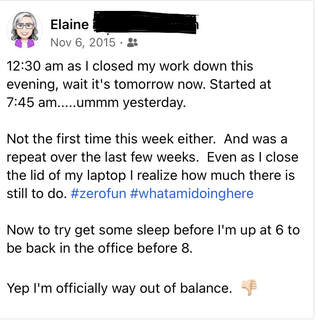My Dad had a triple bypass at age 45 so you can imagine what I was thinking.; it messed with my head. The doc insisted I take a minimum of two weeks off with absolutely no work. I went to a clinic the next day for a heart stress test and sent home with a holter monitor (heart and blood pressure thing)
Something happens to you when you have a health scare and realize it's been cause by the work that you hate doing. You immediately start taking stock and assess what steps you need to take to make it stop.
0 Comments
Do Your Employees Hate Work?When great employees don’t get what they need to thrive, they wither and become a zombie before your eyes.
Has your previously amazing rock star employee turned into one of the ‘working dead’..... that quit, but stayed? How would you know if you have disengaged employees? Sometimes, it is not very obvious. Zombie employees may get sick frequently; they may complain or stew about issues more; they are more detached; they increase the number of breaks or take a long time to accomplish work; or, they seem more frustrated or annoyed. When team members, who were previously quite involved and full of life, become quiet or just don't bother trying anymore - there is a good chance they're checking out. It is becoming quite an epidemic. According to Gallup less than 13% of employees are an engaged worldwide – that means many people hate their jobs. With a concerted effort you can bring them back from the brink while preventing the further demise of your very best people. Rebuild Team Trust After LayoffsSo your team has been restructured and the dust finally settled.
Now, you’re supposed to go back to ‘business as usual’ but things feel far from normal. As the leader, you’re in a tough position because everyone on your team turns to you for answers and clarity. But, you're as much in the dark as they are, maybe a bit ticked off too....so what do you do? Rest assured you’re not alone; heck, you can’t read a newspaper or hear a business report these days without learning about a company cutting back, laying off or reorganizing. Just like you, there are hundreds of leaders trying to find their way to get back on track, regrouping but also trying to rebuild trust of the ‘survivors’. Poor Communication = No ConnectionThese days, with all the tools we have available, we are far more connected and capable of staying in touch than ever before!
So don’t you find it a bit ironic that in today’s workplaces, lack of communication remains one of the biggest issues for employees? Regardless of the industry or size of company! Here’s the thing - if your team doesn’t feel heard, they don’t understand the direction of the company, never get constructive feedback, or they don’t think you care about them as a person, then why would they give you their best work? Have You Asked Yourself, Am I a Credible Leader?I heard about Tom through leaders in other departments and some of his team.
Tom was a top-level leader; he was sharp, rather humorous, a technically-adept-quick-study, and very good at corporate politics in his highly specialized C-suite role. However what Tom didn’t know, was that most of his team had lost total respect for him as a leader; they didn’t believe half of what he said and few trusted him anymore. As a result, team morale was at an all time low, they spent much of their time cross-checking the many stories he told, second-guessing his every move and gossiping about Tom’s life outside of work. When Work Sucks, You Need to GoTime to go – those words rang through my head when I caught up with a work-friend I hadn’t seen in years, as she told me about her job.
It all came back to me... the dreadful soul-sucking heaviness when my old job became absolute drudgery. Looking back, I knew in my heart it was time to go but I continued to persevere, pushing myself to do work that wasn’t ‘me’. I told myself that it was a good job with good pay so I’d be crazy to think about leaving …it even had a pension, and who leaves that at my age! That is her situation too; she is suffering in a job that no longer serves her and she feels so stuck. Does Your Team Trust You?Hey did you hear? Prime Minister Trudeau admitted there was an ‘erosion of trust’ occurring in his office; he was unaware of it (based on what came out in the recent Canadian justice committee inquiry). Imagine his disappointment to find that people did not feel comfortable coming to him with concerns.
Well sadly, he is not alone, many leaders realize a little late that there are issues or an underground culture (where they are excluded) in their workplace. It may not come to light until exit interviews, employee surveys or worse, formal complaints. I get it! Difficult people on your team can zap your energy ‘getting on your nerves,’ making it a pain to work with them. Well guess what, I’m here to tell you that pretty much every difficult person you will ever lead, can be a great asset; you may even find them not so difficult after all! This series has been dedicated to helping you figure out how to tap into hidden potential of difficult types and minimize the frustration: - Part one when you’re challenged with a “The Know All” (TKA) - Part two for the blow it up Revolutionary type (TNT) or - Part three the Take No Prisoners (TNP) personality type To wrap up the series, I’m going to help you with one seldom discussed, often misunderstood and a very draining style to work with… the Constant Critic (TCC)! You know this type; they tend to be appear very negative. Just like Eeyore (from Winnie the Pooh) who constantly points out the negative in every move. They don’t cause big drama but they do seem reluctant to get onboard with anything new, usually based on some prior experience. The Constant Critic profile:
Meet Pete – “Mr. Quiet Dissonance” Pete (name changed) has an accounting background and works as a Director, Strategic Planning & Performance for a large Retailer. He's been an executive for 5 years but has been with the company for over 20. The 3 people who report to him quite enjoy working with him. He reports to Marnie (not her real name), VP Business Performance who was recently promoted. Marnie and I have been working together on improving her direct team’s collaboration and she asked for help with Pete, in particular. Pete is commonly referred to as the ‘company historian’ and has lived through a couple of mergers, several name changes as well as take over from a US-based company. Marnie was forewarned that Pete seemed disengaged before she took on the team.
Pete is a great example of the Constant Critic personality type! The good news is Pete responded positively to Marnie as soon as she began implementing strategies we spoke about. Her action plan included:
At this point, her focus is on developing more of a trusted relationship, and that maybe all it takes. Marnie's increased interest in his experience seems to have had a positive impact already; the team has noticed Pete becoming more participatory – no more crossed arms in meetings and some have even commented about him being more sociable. The benefit of having a TCC on your team – great devils advocate, can help you develop persuasive arguments, often sees a different perspective and helps to reflect on pending plans. Often they have learned from past mistakes, can be a historian with very helpful information to draw upon. The key to leading a TCC – remain positive, redirect negativity, stick to facts and data that support positive outcomes. Help them see the impact of their behaviour on others if it becomes a problem. Ask the TCC to reframe their initial reaction toward a more positive response. Caution leading a TCC – do not get pulled into negativity. Limit how much time you give when they become negative. For every difficult type of person, there is a way of changing YOUR perspective about what contribution they bring to your team. It may take a little effort, but drawing upon unique perspectives can be a competitive edge for your team. If you are dealing with a difficult person on your team (or even your boss) and you’d like help to figure out how to communicate better with them, send me an email. There are just as many strategies as there are difficult personality types! Bonus tip: Can you see a bit of yourself in Pete? Have you been 'shutting down' at work, avoiding colleagues or find yourself to be increasingly contrary? You may be a Constant Critic or are heading that way. Time to reflect on how negative you may appear to others:
Photo CC0 @bkotynski Unsplash
According to Gallup State of the Global Workplace, 85% of employees worldwide are not engaged or are actively disengaged in their job. “The low percentages of engaged employees represent a barrier to creating high performing cultures around the world. They imply a stunning amount of wasted potential.” Wasted potential. How that phrase resonates with me! Death by Administration I'm sad to say, I was one of the walking ‘wasted potential’ not too many years ago. It was a dark and miserable time. My employer was doing a massive restructure, removing spans and levels of management and it was my job, as the HR lead, to implement it for my division. Unfortunately the process they undertook was more of a spreadsheet exercise, versus strategic. So the work I loved and excelled at suddenly switched from senior level advisory work to a massive load of mundane administrative tasks Every. Single. Day. , and it went on for months. This kind of work was my worst nightmare and even though it is hard to admit..I have never been very good at mind-numbing administrative work. It just wasn't the right work for me. What a complete waste! Wasted potential. People can’t thrive when they are doing the wrong work. It devalues them, misuses talents and creates unnecessary pressure. During stress-filled change, leaders can fall asleep at the helm; too busy ducking for cover, they completely overlook the signs of utter disengagement around them. Don’t waste your best resources like that; you will surely lose your highest potential people when you don’t pay attention.
Expert Lessons A great way to stem the tide of employee disengagement is to tap into the abilities of EACH and every person on your team. Get people doing the right work utilizing their best skills, long before a change occurs. According to Gallup's survey analytics it is your high potential talent that will take a walk if they are not engaged, long before the others. These top talent are the experts to learn from! Here is what top talent say will help keep them: Lesson 1
Lesson 7
Engagement Counts The best leaders demonstrate they care about each and every team member by taking an interest. They pay attention, particularly during stressful times, leveraging potential vs wasting it. They make it a practice to develop potential, all the time. They allocate work in a way that plays to their people’s strength and they keep them connected to the bigger picture. When you demonstrate YOUR engagement, harnessing the potential of your best and brightest, you are guaranteed better results for highly engaged employees. If you have a disengaged team (or team member) or are leading through stressful times and need support, I’m only an email away! I help leaders grow and develop by working with them through the toughest of times. I offer a 30-minute free consult. I want to hear from you, tell me about your own experience in the reply section below. Image: CC0 Creative Commons/Pixabay
How to Avoid BurnoutChange can be a dirty word in many work environments today. Lets face it “Transformation” is the buzzword de jour! Almost everyone is feeling the affect of increased workload and the speed of change in their job.
It may be brought on from process improvement, new-fangled technologies to learn, added responsibility, regulatory scrutiny, or the most-feared-change of all…downsizing! Constantly having to adapt, even for the best leaders, takes quite a toll. As a leader not only do you have to continually reframe and communicate the gist of the changes to your team, but you are also expected to be ‘on’ and supportive of whatever is thrown your way. This can be downright exhausting! So how IS change affecting you? Are you coping? Or are you nearing burnout? Take this simple assessment to find out: It could be you’ve heard of others being let go; you’ve seen a shake up at the top leadership levels or you suspect your new boss is really here to restructure. Any of these scenarios can make you uneasy about your own job stability. And once the anxiety sets in, it can affect your normal ability to focus, make you dread every unexpected meeting or just make getting up to go to work, feel miserable. Given the percentage of our life we spend at work, this ongoing negative stress can be bad for your health so it is worth finding productive techniques to take back control. If you are one of those people sensing impending doom, I’m here to say relax, don’t let it unnerve you. Instead let me show you how to actually take full advantage of it. While I can’t guarantee you won’t be on the chopping block, I can help you reframe your mindset and give you hope for a much more positive outlook. Simply by learning how to Duck, Prepare to 'Jet' and/or get ready to make a Career Pivot!
Duck! Here is how ‘Duck’ worked for one of my corporate clients: I’ll call her Eileen; Eileen had a new boss, a bossy boss with a big ego, who she didn’t see eye-to-eye with. My advice was this - get on with the work, don’t act in an artificial way, just keep the focus on doing a good job. It wasn’t always easy. Eileen asked clarifying questions to understand what her boss wanted and then delivered accordingly. She gave the boss no cause to centre her out, no angry or emotional outbursts – she kept her head down and managed her emotions. (We would often debrief after the tough days). We found that when she focused on only what her manager asked for, it became much easier for her to cope day-to-day. This gave her personal control. She controlled her reaction, her output, and her thoughts. The goal was to deliver, and deliver she did! Only those close to her ever knew the true feelings of doubt and worry. She is a great example of how positively shifting your state of mind gives you the ability to work through job stress. She proved to me that anyone could overcome the dread just by changing your mindset! This concept not only reduced stress for few years until the boss moved on, but she said it taught her to become more focused and action oriented. Every Exit is an Entry Somewhere The other strategy is to get ready to 'jet' (aka. leave, exit, vamoose, hit the road). This means ACCEPT that you are going to go, stop worrying about it and begin your own transition now…while you’re still working! I always tell my clients “you have the gift of time so lets use it to your own benefit.” Think of it as extra paid time to regroup, plan and prepare for your next move. Here are some action steps I suggest to create change, on your own terms:
Create an action list with target dates to be done by:
This mind shift is a game changer to overcome the oppressive feeling of dread. You invest in yourself and take back some time. If all goes really well, you’ll receive a nice little severance package AND start your new job shortly thereafter. Or you may land a great job before they send you packing – either way is a positive outcome! Consider a PIVOT! Treat this as a defining moment in your career where you sit back, take stock and re-evaluate what YOU want for your future. It’s the perfect time to consider an intentional career change in a completely different direction! Maybe there are departments you’ve had a yearning to join but never had the courage to apply? Perhaps you may have been thinking of starting your own business, or you’ve had a side hustle that you should consider if you can do it full-time? I’ve had clients take this opportunity to plan to return to school, become certified in a speciality or finish higher level education that later jettisoned them on to a successful new chapter in their life. Regardless of where the pivotal change takes you it usually needs a catalyst to push you over the edge and make that wishful change happen. Turning the dread into a meaningful plan can make all the difference. Need a Career Lifeline? I’ve supported several leaders through this uncertainty, waiting for the day they will be let go. I’ve also sat on the other side, breaking the news of downsizing to quite a few people and I can say with 100% confidence that everyone finds a new path and 9.8/10 times they end up happier than before. Rather than let the worry drag you down or make you sick, I say shift your thinking to make it work for you! The big trick is finding ways to take back control, accept change quickly – better yet, embrace it! If you find yourself stuck and want to work with a professional to review your options, create a personalized career plan, hold you accountable or give you candid feedback, advice and insight, give me a call or send me an email! I offer a 30-minute free consultation. Regardless of the scenario that has you anxious or worrying about job loss, I’d love to help you ‘connect the dots’ for the next phase in your career! Image: CC0 Creative Commons
Sitting together at a big oak table, in her spacious corner office on the 24th floor overlooking Bay and Wellington Streets in Toronto, my well-respected client asked me to help her map out the next steps in her career. She felt stuck; almost embarrassed that she was misaligned to her career after all it took to get there. Proof that even when you reach the coveted C-suite, you can still feel discontented or unfulfilled in your job. Most people associate their sense of self and identity with the work they do and paycheque they make. You can see how difficult it would be to determine where to make the next move when you find yourself in this situation. Where to Begin I often suggest watching a TED Talk by Adam Leipzig, called How to Learn Your Life's Purpose in 5 Minutes. One of most popular TED Talks of all time, with more than 8.5 million views. In less than 10 minutes Adam provides 5 key questions to help identify your life’s purpose. It’s a great start to expanding your view on what you should do to give you fulfillment. I use a variety of introspective tools as well as questioning techniques with my clients. If you feel stuck, or in a fog you’ll find a snippet of questions below that can begin to clear your view. This reflective exercise activates ideas, narrowing in on clues you can use to reimagine a more rewarding career or job. Your Calling Many of us are forced to make life-long choices selecting education specialties or career direction with minimal information about who we are and what we are best at. Seldom are we given tools to help identify what path to take. Caught up in the tsunami of life and career, it sweeps you along without much time for reflection. In fact, sometimes it takes years of doing the wrong thing before it really dawns on you that you’re way off base! Few can afford to leave their job to experiment and dabble in other fields to figure out where the right place is; instead you need a solid plan with a process to follow. What I’ve found best is to carve out time for self-reflection and introspection. Then seek feedback and dig into your strengths, doing this opens you up to connect with your calling. YOUR CALLING = the intersection between doing what you love and the ability to make money doing it! Who AM I Really? The answer to the right place for most people is typically tied to who they are and have always been. There are trails of evidence that you can relate to when you go through this exercise. Similar to Adam’s Ted Talk these questions help you uncover what you’re meant to do.
Connect the Dots While it seems a simple exercise, this reflection actually takes work to gather and time to contact and listen to as many people as you can. It is vital that you remain open to hear feedback without judgement. Take notes, ask clarifying questions and avoid judging or defending. I always say feedback is a gift! So just accept whatever points people share and say thank you, graciously. Armed with this information, you will find some obvious clues to connect the dots for what you are meant to be doing. The key to success in the future lies in leveraging your very best traits and skills while focusing on areas you’ve had the most enjoyment and impact to others. Impact to others is a crucial piece of data few ever collect. Service to others, or making a positive impact is a critical building block to most people’s work contentment. From here brainstorm, look at what you can change in your current job to better align with your purpose. But also look for project work, roles, departments, or other industries and your network for potential opportunities to consider. The path isn’t always immediately obvious. Some people stay within their job working on the side with charities, volunteering or mentoring others or contributing to the greater good in other ways. Craft an action plan to network further, identify potential jobs that leverage what you’ve done so far, look at independent work or other businesses where you can fully utilize all that makes you unique. If you find yourself struggling in a job that leaves you feeling undervalued, and want assistance from a leadership coach to help guide you , provide feedback and gain clarity with accountability to follow through, please send me an email! Or if you’d like to delve deeper into who you are and what makes you tick, please reach out. It would be a privilege for me to help you find work you love! Photo: Creative Commons Zero (CC0) license
Previously in this series, I covered the various phases of building a kick-ass team, including the ‘Start Up’ phase, ‘Building the Team Identity’ phase, ‘Bust Through the Barriers’ phase and ‘Kum Ba Yes’ phase. By now, if you’ve implemented all of my suggestions, you should be experiencing the ‘High Performance R Us’ phase – high five to you for graduating to a kick-ass leader!
What Does This Phase Look Like? You’ll know the ‘High Performance R Us’ phase when you see your team consistently triumph and achieve goals together. For the most part, they get along, openly discuss ideas, problems and solutions, and most importantly, they share recommendations for improvement, actively solving issues together and demonstrating commitment to the group and company. Generally the climate is positive and activated for achievement. This kind of high performing team emits a positive vibe, and as such, they make the customer (internal or external) want to work with you. So…now what? What do you do once you’ve successfully attained a high performing kick-ass team? Some say great teams eventually come to an end, but I like to think its more of a metamorphosis–just like a butterfly, your people undergo a change that gives each individual courage and esteem, which often means they will move along. Kick Ass Leaders Shift Gears At this point, some members of your team will either take on new roles within the team or move along, triggering a change to the whole dynamic. Similarly, this may also be a time when you prepare to make your own move, or you earn that well-deserved promotion! Lets look at how you can either course correct to help your team through changes or how you can begin to wrap up so you are ready to make a move: Course Correction After the team dynamic changes or the team divides after having been together for a long time, you may notice a shift in peoples’ behaviours. Watch out for complacency, disengagement or repeated illnesses. Even the highest performing employees can become frustrated with changes–they are usually the first to exhibit fluctuations in behaviour. Keep an eye on things like:
These are often symptoms of disengagement or complacency. How to Respond
Wrapping Up With Your Team If you’ve instead decided to make a move and depart from your now, high-functioning team, it’s imperative that you take right steps to leave them on great terms and in great shape. Parting ways can be difficult, but if you follow the wrap up checklist below, you’ll be sure to leave on a positive note. Check In – take time to check in with the team to reflect–review the vision and mission you designed in Part 1 and 2 and have your team help you assess the progress. Record what worked and what could have been better, and identify how the team adapted to changing requirements over the duration. Determine what were the best parts of this team and which core competencies made the group most successful and why.
Check Off – take time to celebrate the journey of the team and reflect on the growth of each team member. Sit down with a coffee and make a list of how you’ve seen each of them grow as you look back over the time you spent together. Be sure to exchange written feedback so they can keep track of their progression and enjoy the fruits of their labour – this can be done using formal performance review tools, emails or, better yet, hand written notes. Thank everyone who helped the team succeed and encourage team members to write notes to support people from other areas in the business or to vendors/suppliers who were instrumental in the success. Send a summary to your boss or present the overview at a peer meeting to acknowledge progress of the team. And don’t forget to book a fun gathering too – coffee, ice cream, drinks or an outing together will allow you to clink glasses and leave on a high note.
Check On – if you haven’t done it already, be sure to communicate to your management and HR department who on your team has high potential and may be ready to take on leadership roles. Be sure to have a development plan laid out for those specific individuals, to ensure they work on acquiring the missing skills needed to make the leap to the next level. You can continue to be a mentor whether you continue to be their boss or not.
Check Out – one of the best things about having a high performing team is the ability to export some of your talented people to other areas of the organization. Reach out to various leaders you know in other areas of the business and connect them with team members who you feel would be valuable contributors. This is a great way to help your people shine and begin kicking off their own amazing team! You can bet they will come to you as they go through their own kick-ass team development.
I hope you’ve enjoyed the journey of kick-ass team building–no doubt, you’ve noticed some consistent themes. Becoming a Kick-Ass Leader takes a great deal of effort, a lot of communication, and the ability to know when to be tough, when to take the reigns or when to let your people soar. As always, I’m at your service if you’d like help in dealing with the various phases of building your team. Reach out any time. |
Most Popular Posts:
AuthorElaine Adamson is a leadership consultant with Dots Leadership Solutions Inc. A natural dot connector. Passionate about coaching team effectiveness and leadership development she shares over 25+ years of real-life tips and tricks that really work! 
Elaine believes you can discover and leverage strengths to forge a strong team dynamic despite business challenges or organizational change.
She posts some great articles on Linked In too! Topics of Interest
All
Archives By Date
November 2022
|
Specialties |
Company |
|















 RSS Feed
RSS Feed